The Interstellar Medium
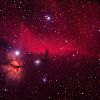
| H. E. Smith | Winter 2007 |

|
|
Physics 7 - Lecture Summary #13
(Continued) The Interstellar Medium |
 |

Although space is very empty and the stars in the Milky Way are very far apart,
the space between the stars contains a very diffuse medium of gas and dust
astronomers call the interstellar medium (ISM). This medium consists of
neutral hydrogen gas (HI), molecular gas (mostly H2), ionized gas
(HII), and dust grains. Although the interstellar medium is, by several orders
of magnitude, a better vacuum than any physicists can create in the laboratory
there is still about of 5-10 billion
M of gas and dust out there, comprising
approximately 5% of the mass of visible stars in the Galaxy.
of gas and dust out there, comprising
approximately 5% of the mass of visible stars in the Galaxy.
The Milky Way Galaxy is filled with a very diffuse distribution of neutral hydrogen gas which has a typical density of about 1 atom/cm3 (10-24g/cm3). The interstellar medium is far too cool to excite the UV or optical transitions of hydrogen, but there is a feature at 21 cm wavelength in the radio produced by the spins (magnetic fields) of the hydrogen atom's nuclear proton and orbiting electron. Because the proton and electron are spinning distributions of electric charge they create minute magnetic fields which interact, creating a small energy difference between the state in which the poles are aligned versus counter-aligned. This energy difference corresponds to the energy of radio waves at 21-centimeters. Every once in a while (about once per 500 years) hydrogen atoms will collide, exciting an atom into the higher energy spin-aligned configuration. It will take as long as 30 million years for the atom to jump back to the lower energy state via a spin-flip, emitting 21 cm radio emission.
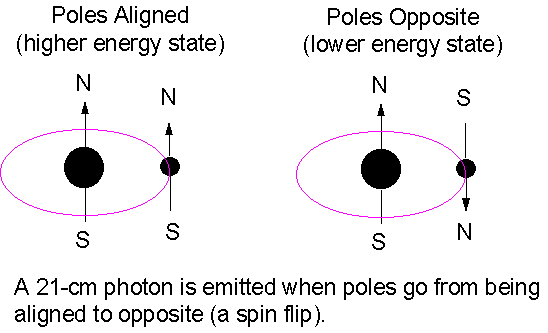
The neutral hydrogen is distributed in clumpy fashion with cool, denser regions that astronomers call "clouds" but which are more like filaments. These regions have a typical temperature of about 100K and a density between 10--100 atoms/cm3. Surrounding the clouds is a warmer lower density medium with about 0.1 atom/cm3 and T ~ 1000K.
Comparatively dense (nH2 >
1000 molecules/cm3), cold (T ~ 10K) clouds of molecular hydrogen
and dust, known as
molecular clouds or dark clouds are the birthplaces of
stars. We do not detect molecular hydrogen directly, but infer its
characteristics from other molecules, most often CO. Over 50 other
molecules have been detected including NH3, CH, OH, CS and
molecules as complex as ethyl alcohol (C2H5OH - the
stuff in whisky) have been found in Milky Way molecular clouds. The
Horsehead Nebula
(Messier
Nebulae, Web Nebulae)
to the right is produced by the incursion of a plume of
dust from a molecular cloud, covering the lower half of the image, into a
region of ionized hydrogen. A Giant Molecular Cloud (GMC) may have a
mass of 106M  and a diameter
of 150 l.y. Within the GMCs are warm dense corse of order 2-3 l.y. in
diameter, with T~100K and densities as high as
n~107-109 molecules/cm3. It is in these
regions where the star-formation process begins. There are thousands of
GMCs in the Milky Way, mostly on the Spiral Arms and concentrated toward
the Galactic Center. The total mass of molecular gas is estimated to be
about equal to, or perhaps somewhat less (~25%) than, the mass of HI gas. and a diameter
of 150 l.y. Within the GMCs are warm dense corse of order 2-3 l.y. in
diameter, with T~100K and densities as high as
n~107-109 molecules/cm3. It is in these
regions where the star-formation process begins. There are thousands of
GMCs in the Milky Way, mostly on the Spiral Arms and concentrated toward
the Galactic Center. The total mass of molecular gas is estimated to be
about equal to, or perhaps somewhat less (~25%) than, the mass of HI gas.
|
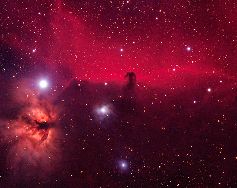 |
Material left over from the formation of young, hot stars represents the most spectacular component of the ISM, the ionized hydrogen or HII regions like the Orion Nebula ( Messier Database, Web Nebulae), shown below in this HST mosaic. Here is the Near Infrared view of the Orion Nebula.
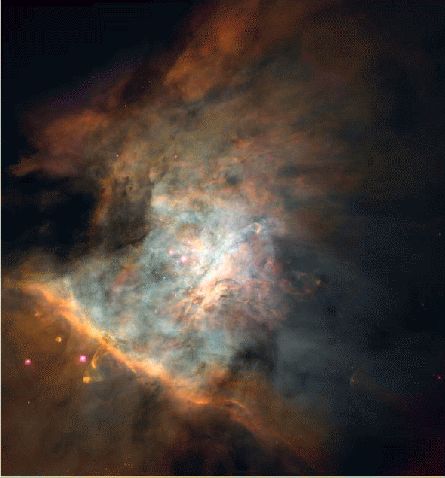
Massive O and B stars, recently formed in molecular clouds (remember - massive stars live fast & die young!) ionize the gas left over from their formation heating it to a temperature, T ~ 10,000K and causing it to fluoresce producing an emission-line spectrum.

Ultraviolet photons from four massive stars called the Trapezium in the nebula have sufficient energy to strip the electrons completely away from - ionize - hydrogen atoms. This requires a photon of energy greater than 13.6 eV or wavelength less than 912Å in the ultraviolet. If a hydrogen atom absorbs a photon with wavelength less than 912Å the atom is ionized with the "extra" energy going into the kinetic energy of the electron. Collisions between electrons "thermalize" this energy heating the nebular gas to a temperature of about 10,000K. Collisions between electrons and ions in the gas excite the ions to higher energy levels producing emission features of O+,O++,N+, S+, etc. as shown in the above spectrum. Electrons recombining to upper level in hydrogen and helium cascade through many energy levels down to the ground state producing the emission features of H & He.
The Orion Nebula is a bubble on the side of a much larger Giant Molecular Cloud complex. The GMC contains a lage cluster of newly formed stars
Scroll down this page to see a selection of HST images of Orion showing circumstellar disks surrounding pre-main sequence stars of solar mass.
| Principal Constituents of the ISM | ||||
|---|---|---|---|---|
| Total Mass (M  ) ) |
"Cloud" Mass (M  ) ) |
Density (cm-3) |
Temperature (K) |
|
| HI gas | ~5 x 109 | 0.1-10 | 100-1000 | |
| H2 gas | 1-5 x 109 | 105-106 | 103-105 | ~10 |
| Dust | ~5 x 107 | ~40 | ||
| HII gas | 100-1000 | 103-104 | 10,000 |
About 1% of the mass of the ISM is in the form of tiny grains of dust about the size of particles of cigarette smoke. We have already described how this dust obscures the plane of the Milky Way from our view. We know something about the characteristics of this dust from the way that it scatters visible and ultraviolet photons. The effect of dust is to dim the light from distant objects (interstellar extinction) in the Galaxy and redden the colors (interstellar reddening) because red light is not scattered as efficiently as blue light.
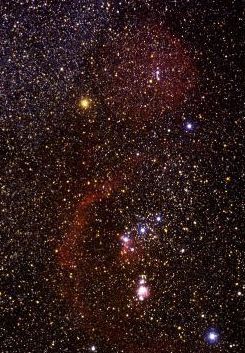 |
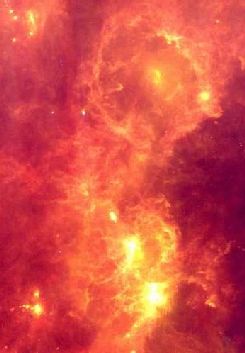 |
| The Constellation Orion: | |
| Visible Light ( S. Kohle & T. Credner, Univ. Bonn) | Infrared ( IRAS Image, IPAC/Caltech) |
A graphical exhibition of the effects of dust at different wavelengths is shown
by the visible and infrared images of the constellation Orion above. Dust
scatters and obscures visible wavelengths where stars emit most of their light
(note Betelgeuse the bright red giant at Orion's left shoulder). Dust is
largely transparent in the infrared, but at temperatures of about 40K, emits
strongly at wavelengths between 50-100 m.
m.
We know that dust grains are elongated, perhaps needle shaped, with sizes of about 1000Å, about the wavelength of light that the grains scatter most efficiently. Dust characteristics vary somewhat from place to place in the Galaxy, but a typical grain is believed to be composed of carbon in a graphite-like crystal structure, mixed with silicates (eg MgSi03 like olivine). Nearly all of the elements like Carbon and Silicon in the ISM are tied up in dust. In molecular clouds the grains appear to be coated with a water-ice shell. Ned Wright at UCLA has developed a fractal model for interstellar dust grains shown in this APOD.
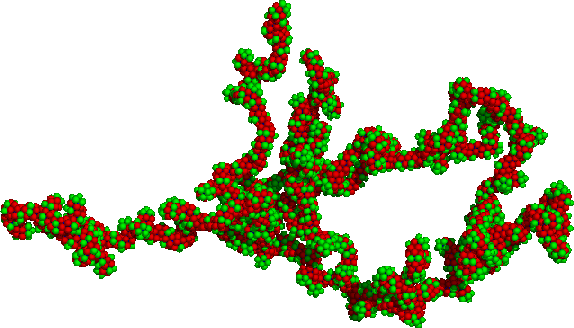
Dust is responsible for the blue haze around the Pleiades star cluster (Messier Database, (Web Nebulae); this nebulosity is called a reflection nebula resulting from blue light from the hot B-stars being scattered toward us from dust surrounding the cluster stars.
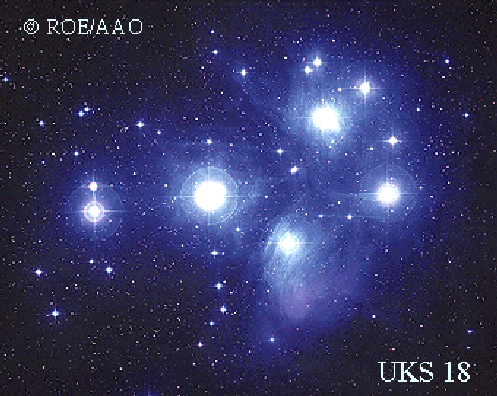
Supernova remnants like the Crab Nebula enrich the ISM with elements heavier than helium as the expand into the ISM with speeds of several thousand km/s.

![]() The Distance Scale
The Distance Scale
![]() The Milky Way
The Milky Way
![]() Physics 7 Lectures
Physics 7 Lectures
![]() Physics 7 Home
Physics 7 Home
Conducted by Gene Smith, CASS/UCSD.
Comments?
You may send email to hsmith@ucsd.edu
Prof. H. E. (Gene) Smith
CASS 0424 UCSD
9500 Gilman Drive
La Jolla, CA 92093-0424
Last updated: 16 February 2001